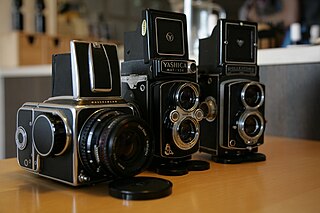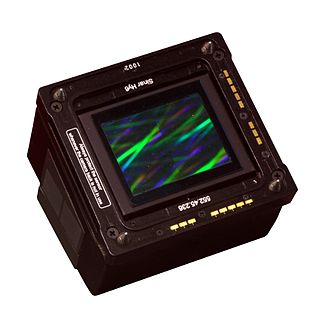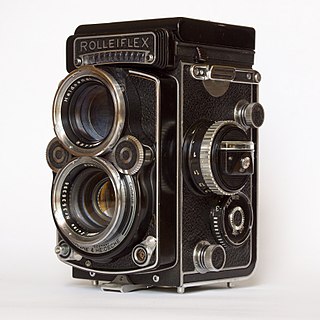
A single-lens reflex camera (SLR) is a camera that typically uses a mirror and prism system that permits the photographer to view through the lens and see exactly what will be captured. With twin lens reflex and rangefinder cameras, the viewed image could be significantly different from the final image. When the shutter button is pressed on most SLRs, the mirror flips out of the light path, allowing light to pass through to the light receptor and the image to be captured.

A rangefinder camera is a camera fitted with a rangefinder, typically a split-image rangefinder: a range-finding focusing mechanism allowing the photographer to measure the subject distance and take photographs that are in sharp focus.

A twin-lens reflex camera (TLR) is a type of camera with two objective lenses of the same focal length. One of the lenses is the photographic objective or "taking lens", while the other is used for the viewfinder system, which is usually viewed from above at waist level.

Victor Hasselblad AB is a Swedish manufacturer of medium format cameras, photographic equipment and image scanners based in Gothenburg, Sweden. The company originally became known for its classic analog medium-format cameras that used a waist-level viewfinder. Perhaps the most famous use of the Hasselblad camera was during the Apollo program missions when the first humans landed on the Moon. Almost all of the still photographs taken during these missions used modified Hasselblad cameras. In 2016, Hasselblad introduced the world's first digital compact mirrorless medium-format camera, the X1D-50c, changing the portability of medium-format photography. Hasselblad produces about 10,000 cameras a year from a small three-storey building.

Medium format has traditionally referred to a film format in photography and the related cameras and equipment that use film. Nowadays, the term applies to film and digital cameras that record images on media larger than the 24 mm × 36 mm used in 35 mm photography, but smaller than 4 in × 5 in.

A slide projector is an optical device for projecting enlarged images of photographic slides onto a screen. Many projectors have mechanical arrangements to show a series of slides loaded into a special tray sequentially.

Mamiya Digital Imaging Co., Ltd. is a Japanese company that manufactures high-end cameras and other related photographic and optical equipment. With headquarters in Tokyo, it has two manufacturing plants and a workforce of over 200 people. The company was founded in May 1940 by camera designer Seiichi Mamiya and financial backer Tsunejiro Sugawara.

A digital camera back is a device that attaches to the back of a camera in place of the traditional negative film holder and contains an electronic image sensor. This allows cameras that were designed to use film take digital photographs. These camera backs are generally expensive by consumer standards and are primarily built to be attached on medium- and large-format cameras used by professional photographers.

Rollei was a German manufacturer of optical instruments founded in 1920 by Paul Franke and Reinhold Heidecke in Braunschweig, Lower Saxony, and maker of the Rolleiflex and Rolleicord series of cameras. Later products included specialty and nostalgic type films for the photo hobbyist market.

Rolleiflex is the name of a long-running and diverse line of high-end cameras originally made by the German company Franke & Heidecke, and later Rollei-Werke.

Sinar Photography AG is a Swiss company based in Zürich manufacturing specialized high-resolution view cameras for studio, reproduction, landscape and architecture photography.

The Rolleiflex SL35 is a range of SLR cameras manufactured and sold by the German camera maker Rollei from 1970 to 1982. This range of cameras uses 35mm film. The camera bodies were initially made in Germany. After Zeiss Ikon discontinued camera production, Rollei acquired the Voigtländer brand and camera designs in 1972, and began producing a second generation of SLR cameras in Singapore starting from 1976. Some of those second-generation cameras were rebranded and marketed as Voigtländer VSL.

The Rolleicord is a medium-format twin lens reflex camera made by Franke & Heidecke (Rollei) between 1933 and 1976. It was a simpler, less expensive version of the high-end Rolleiflex TLR, aimed at amateur photographers who wanted a high-quality camera but could not afford the expensive Rolleiflex. Several models of Rolleicord were made; the later models generally had more advanced features and tend to be valued higher in today's market.

The Rollei 35 is a 35mm miniature viewfinder camera built by Rollei. The original Rollei 35, when introduced at photokina in 1966, was the smallest existing 135 film camera. The Rollei 35 series remains one of the smallest 35 mm cameras after the Minox 35 and Minolta TC-1. In 30 years, about 2 million Rollei 35 series cameras were manufactured. The Rollei 35 was manufactured by DHW Fototechnik up to 2015, the successor of Franke & Heidecke as small-batch production. The last version is the Rollei 35 Classic, an updated Rollei 35 SE.

The Rolleiflex SL66 is a line of medium format single lens reflex cameras made by Rollei, in regular production starting from 1966 until Rollei's bankruptcy in 1982. The SL66 represented a change in direction for Rollei, which until that time had focused almost exclusively on its popular twin lens reflex cameras, the Rolleiflex and Rolleicord.

Leaf is an Israeli company that manufactures high-end digital backs for medium format and large format cameras. It was previously a division of Scitex and later Kodak, and is now a subsidiary of Phase One. In 1991, Leaf introduced the first medium format digital camera back, the Leaf DCB1, nicknamed ‘The Brick’, which had a resolution of 4 million pixels. As of 2012, Leaf produces the Credo line of digital camera backs, ranging from 40 to 80 megapixels. Until 2010, Leaf also produced photography workflow software Leaf Capture.

The Rolleiflex SLX is a line of medium format single lens reflex cameras made by Rollei, in regular production starting from 1976. The SLX incorporated electronic autoexposure and motorized film transport, competing directly with the integrated-motor Hasselblad 500EL/M and effectively displacing the earlier Rolleiflex SL66 line, although the older camera continued to be produced.

The Rolleiflex 6000 System is a line of medium format single lens reflex cameras made by Rollei, in regular production starting from 1983 with the 6006. The 6006 was derived from the earlier SLX (1976) and retains compatibility with its lenses and accessories, adding an interchangeable film back with an integral dark slide. Like the SLX, the 6000 series cameras incorporate electronic autoexposure and motorized film transport, competing directly with the line of similar integrated-motor Hasselblad V-system cameras which started with the 500EL.



















